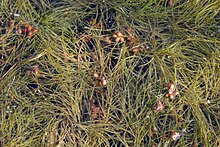
Potamogeton is a genus of aquatic, mostly freshwater, plants of the family Potamogetonaceae. Most are known by the common name pondweed, although many unrelated plants may be called pondweed, such as Canadian pondweed. The genus name means "river neighbor", originating from the Greek potamos (river) and geiton (neighbor).

Tripleurospermum inodorum, common names scentless false mayweed, scentless mayweed, scentless chamomile, and Baldr's brow, is the type species of Tripleurospermum. This plant is native to Eurasia and North Africa, and introduced to North America, where it is commonly found in fields, fallow land and gardens.

Potamogeton natans, commonly known as broad-leaved pondweed, floating pondweed, or floating-leaf pondweed, is an aquatic species in the genus Potamogeton native to quiet or slow-flowing freshwater habitats throughout the Holarctic Kingdom.

Potamogeton perfoliatus is a perennial aquatic plant in the family Potamogetonaceae occurring in both standing and flowing freshwater habitats. It is widely distributed globally, occurring in all continents except South America and Antarctica.

Alisma lanceolatum is a species of aquatic plant in the water plantain family known by the common names lanceleaf water plantain and narrow-leaved water plantain. It is widespread across Europe, North Africa and temperate Asia. It is naturalized in Australia, New Zealand, Oregon, California and British Columbia. It is considered a noxious weed in some places.

Potamogeton praelongus, commonly known as whitestem pondweed in North America and long-stalked pondweed in Britain, is a large, perennial aquatic plant in the family Potamogetonaceae. It is widely distributed in lakes and rivers in the northern hemisphere, but is sensitive to poor water quality.

Zannichellia is a genus of submerged aquatic flowering plant, with threadlike leaves and tiny flowers. It is fully adapted to an aquatic life cycle, including underwater pollination.

Potamogeton coloratus, the fen pondweed, is an aquatic plant in the genus Potamogeton. It is found in shallow peaty calcareous lakes, ponds and ditches, commonly associated with lowland fens.

Potamogeton alpinus is a species of perennial aquatic plant known by the common names alpine pondweed and red pondweed. It is widespread in the northern hemisphere in both rivers and lakes with good water quality.

Potamogeton diversifolius is a species of aquatic plant known by the common names waterthread pondweed and diverse-leaved pondweed. It is native to most of the United States, as well as sections of southwestern Canada, and northern Mexico, where it grows in water bodies such as ponds, lakes, ditches, and slow-moving streams. This is a perennial herb producing a very narrow, compressed stem branching to a maximum length around 35 centimeters. It has thin, pointed linear leaves a few centimeters long spirally arranged about the thin stem. The inflorescence is a small spike of flowers emerging from the water surface. Inflorescences also grow on submersed sections of the stem; these are smaller and spherical. It can be difficult to distinguish from similar species of pondweed.

Potamogeton gramineus is a species of aquatic plant known by the common name various-leaved pondweed, variableleaf pondweed, grass-leaved pondweed or grassy pondweed, native to the northern hemisphere where it grows in shallow, clean water.
Stuckenia striata is a species of aquatic plant known by the common names broadleaf pondweedNevada pondweed and striped pondweed. It is native to the Americas, including the southwestern United States, northern Mexico, and parts of Central and South America. It grows in waterways such as rivers, canals, and shallow ponds, often in alkaline water. This is a perennial herb producing a long, thin, branching stem approaching 2 m in maximum length. The narrow, hairlike leaves are up to 10 cm (3.9 in) long and only a few millimeters wide. The inflorescence is a spike of flowers arranged in whorls and borne on a short peduncle.

Potamogeton pusillus is a species of aquatic plant known by the common names small pondweed, lesser pondweed or least pondweed. It occurs in standing and slow-flowing freshwater habitats throughout the Northern Hemisphere.

Sagittaria longiloba is a North American species of flowering plant in the water plantain family known by the common name longbarb arrowhead and Gregg arrowhead.

Potamogeton obtusifolius, known as blunt-leaved pondweed, is an aquatic plant in the genus Potamogeton. It grows mainly in mesotrophic to eutrophic lakes, ponds and ditches, rarely in brackish water. It occurs primarily in Central Europe, the British Isles, Fennoscandia and eastern North America.

Stuckenia is a genus of flowering aquatic plants. It contains approximately 30 species that grow in shallow water. Pondweed is a common name for plants in this genus.

Stuckenia vaginata, commonly called sheathed pondweed, big sheathed pondweed or large-sheathed pondweed is a water plant species that grows in fresh and brackish water in Europe, Northern Asia and North America. Sheathed pondweed is rare, but is not in the 2012 IUCN Red List.

Sagittaria platyphylla, the delta arrowhead, broad-leaf arrowhead or delta duck-potato, is a plant species native to the eastern United States.

Potamogeton friesii, known as flat-stalked pondweed, or Fries' pondweed, is an aquatic plant in the genus Potamogeton. It grows mainly in mesotrophic to eutrophic rivers, lakes, ponds and ditches, rarely in brackish water. It occurs in North America, Europe, western Asia and a few scattered locations elsewhere in Asia.





















